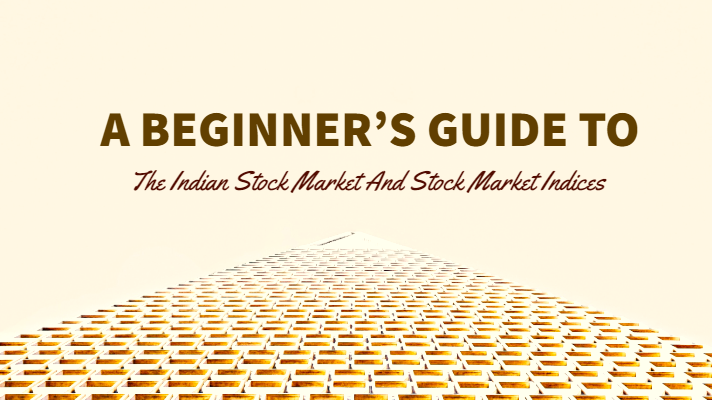Published : June 10, 2019

For those who are investing in the stock market for the first time, the entire process may seem like an exercise in chaos. However, that’s not true. Stock trading, in fact, is a very efficient way to facilitate the buying and selling of securities in the market. Thanks to technology, most of the stock trading can be done with very little (if any) human intervention.
You may feel intimidated in the beginning, with terms like ‘blue chip stocks’ and ‘short selling’ thrown around. But once you get a proper understanding of how stock trading works, you can make substantial financial gains and reach your long term goals with ease.
In this blog, we are going to talk about the stock market and stock market indices, and why you need to know it before making your first bid. Read further to get a primer on the share market and its components.
The stock market comprises of various exchanges and markets where activities such as buying, selling, and issuance of shares and securities take place. Here, buying stocks (also known as equities) represents an interest in gaining fractional ownership in a company. These financial transactions are usually done through over-the-counter (OTC) marketplaces or centralized exchanges, functioning under a specified set of regulations.
It is common for large companies to list their stocks on stock exchanges, as it makes their share more liquid, and consequently easy to buy and sell. Those investors who wish to increase their income without encountering the risk of a new venture with high overheads and startup costs can also choose to invest in the stock market. On the other hand, the sales of stocks help the company to expand and grow, thus making it a win-win for both owner and investor.
Despite it all, there is a risk factor that highly depends on the amount of stock one has been trading. If a stock trader that has invested in the company loses value, then the trader loses it as well. In such a situation, if the trader decides to sell his stocks, he is bound to incur a loss on the sales.
In the stock exchange, various factors are responsible for moving stocks. One of the most common reasons for the indices to go up or down is the changing dynamics in supply and demand. When more traders start purchasing shares instead of selling it, the stock prices go up. On the other hand, when more people sell their shares, no matter the reason, the prices go down.
The way the stock prices rise or fall also determines a company’s worth in the eyes of the shareholders. Here, it is important to know that the stock price is different from the company’s overall market value. Also called market capitalization, the company’s value is in fact determined by multiplying the stock price with the number of shares that are out for sale.
For example, company A that trades at Rs.500 per share with 10,000 shares outstanding will have lesser value than company B that trades at Rs.300 with 1,00,000 shares outstanding. By simple calculation, company B’s value (300 x 1,00,000 = Rs.30,000,000) is more than company A’s value ( 500 x 10,000 = Rs.5,000,000).
Of course, no one can make accurate predictions about the movements of the stock market. Still, here are a few factors that will help you understand it better.
The fundamental data could be anything, from earning reports to cash flow to sales rising, and more. When a stock does fundamentally well, people start putting their money into it, since they know their money is safe. However, once a fundamentals break down (sales decline and rise in the cost of material), traders begin to leave the stock for better opportunities.
The stock chart is the technical aspect of the stock market. The price levels on these stock charts are where you can see the buying and selling of stocks. When these shares near their resistance level, traders start selling their stocks to play it safe. Eventually, there comes a point when too many people have sold their stocks and the market is a bargain again. Known as ‘support’, this phase is when the buyers come back to purchase shares again.
The third thing that affects stocks is practical realities or life events. This includes unexpected circumstances – hurricane, an unexplained oil spill, the explosion of gas – that can affect the sales and commerce of the country.
In India, there are two major platforms for stock exchanges – Bombay Stock Exchange (BSE) or Sensex, and National Stock Exchange (NSE) or NIFTY. Further, the market is also divided into two categories – primary markets and secondary markets. The primary markets are for companies selling their shares for the first time, while secondary markets are for investors who want to trade shares issued during the IPO stage. It is the trades that take place in these stock exchanges that set the momentum of the stock market. Look at how it happens.
It starts with companies filing a draft offer document with the SEBI. The documents contain all the information about the companies (the shares they want to dilute and such). Once the SEBI approves it, the companies put up their shares on the primary market through an IPO.
After the IPO, the company allows shares to different investors who did the bidding at the previous stage. These shares are then listed on the secondary market, i.e., the stock market for trading. The secondary market provides an opportunity for investors who failed to receive shares during the IPO.
Most broking agencies are registered with SEBI and stock exchanges. They act as a mediator between the investors and the Indian stock market. The brokers do all the budding on behalf of their clients. Earlier, the process used to be done manually. However, with the rise of online trading platforms, the process of matching a buyer and seller is done via the internet.
In this stage, the order placed by a broker in the stock exchange is processed. Once a buyer and seller matches, the trade is deemed to be successful and a confirmation message is sent by the stock exchange to both the parties. After which, the executed trades are settled where the buyer receives his shares and the company obtains its funds. Indian stock market has the policy of T+2 settlements, that means the settlement happens within two working days from the day of the transaction.
Once you invest in shares, you start getting returns from dividends and capital gains. It can be in any form, whether as profits incurred from trading or dividends accrued as shareholders. It is important to remember that these returns will not always be profitable and are subject to market risks. The amount you will get greatly depends on the size of risk you are willing to take and how good you are with your stock market analysis.
Another aspect that you must know about the stock market is ‘Holding Period’. It is the time period between the purchase of a security or a stock and its sales. It is usually calculated from the day of purchase of the stock to the day of its sale. The holding period is important as it determines the future tax implications. In case there is a difference in the holding period, you will incur differential tax treatment on your stock investments.
There are several ways to find out if your stock market investment is resulting in profit or loss. Look at a few of them!
Total Return is one of the simplest and most accurate methods of calculating stock returns. Just make sure that you have included dividends in your calculation wherever you think it’s needed. Here’s the formula for total return:
Total Return = (The investment returns at the year‘s end- The investment returns at the year’s beginning) + Dividend/investment returns at the year’s beginning
For Example, suppose that you have purchased a stock for Rs.5,00,000 and now it is worth Rs.5,50,000, so you have made a profit of Rs.50,000. You will also receive a dividend of Rs.4250 during this time. So, what will be the total return here?
(5,50,000 – 5,00,00) + 4250 / 5,00,000
50,000+ 4250/ 5,00,000
54250 / 5,00,000
1.1085% or 11.08% = Total Return
You can calculate the compound return by dividing the investment value incurred at the end of the investment period with the investment value incurred at the beginning of the investment period. Raise the resultant value to a power of one and then divide it by the period length. Finally, subtract one from the previous result, and you will get your compound return.
You are a day trader if you trade financial instruments such as stocks, securities, and futures on the same trading day. Day traders are usually very well aware of the market movements and are experts in taking advantage of moving prices in highly liquid stocks. You need to possess both great assessment skills and the right tools to be a day trader.
Speculators typically have above-average risk tolerance. They use strategies and short time frame to outrun traditional investors with long term goals. Such traders like to take risks by assessing future price movements in order to make substantial gains. Some of the many methods they employ include position sizing and stop loss orders.
As compared to day traders, swing traders spend more time monitoring stocks and considering investment opportunities before making a trade. They follow the dynamics of the stock market. Also they very few stocks interest them in and they make decisions accordingly. Such traders utilize both fundamental and technical analysis to purchase stocks and securities.
The main focus of growth investors is to grow their capital and earn good returns. This is the reason why they only choose growth stocks to invest in. By this, we mean entities whose income is supposed to grow at an above-average rate. You are a growth investor if you don’t mind playing a little safe for more returns.
A value investor is someone who particularly looks out for stocks that are traded at lower rates than their actual value. They look at the various aspects of a company, such as financial statements, operational efficiency, and cash flow to determine if investing in it is worth it.
Stock indices help understand the performance of the stock market. It measures the average value of selected stocks that follow the market index to help traders and investors determine the return on investment on their stocks. The classification of these indices is based on various factors, such as the industry the company is from, the size of the entity, and capitalization of the market. As we know that the indices constitute different stocks. So any change in the value of individual stocks directly impacts the value of indices.
For example, the index of BSE Sensex consists of 30 top companies in India. Likewise, the index of Nifty consists of 50 top companies in India. The index of BSE 500 comprises of 500 top companies in India.
There are basically four types of indices in India. They are:
One of the most preferred ways of industry experts to calculate NIFTY and Sensex is ‘Free-Float Market Capitalization’ method. This method is reliable, offers accurate insights on the market movements, and helps investors make better judgments. It should be noted that in the resultant, the resulting market capitalization is always smaller than the resulting full capitalization.
We use the following formula for calculating the free-float market capitalization –
Free Float Market Capitalization = The Price Of Shares x (The Total Number Of Shares Issued – Shares That Are Locked-In)
With the help of sector-specific indices, traders and investors can benchmark the performance of stocks that are grouped by particular market sectors and industries. It helps companies to make better investments and keep a proper track on the progress of a specific market sector.
The following are few of the sector-specific indices of the National Stock Exchange –
The stock market is a great place to invest in and make a lot of money. However, before you do it, make sure to read up on the stock market and the company as much as you can to avoid encountering future problems. Keep updating yourself with the latest stock marketing tools and techniques to make the best of all stock market opportunities!

Enjoy flexible trading limits at
lowest brokerage rates ?
Open Your Investments Account Now
0Account Opening Charges
Life Time Demat AMC
Brokerage







Ensure the security of your investments by updating your nominee details in your trading & demat account online. It’s quick and hassle-free!
📌 Act Now to Stay Compliant
For assistance, contact our Customer Care at 0562‑4266666 and email askus@rmoneyindia.com.

IT'S TIME TO HAVE SOME FUN!
Your family deserves this time more than we do.
Share happiness with your family today & come back soon. We will be right here.
Investment to ek bahana hai,
humein to khushiyon ko badhana hai.
E-mail
askus@rmoneyindia.com
Customer Care
+91-9568654321